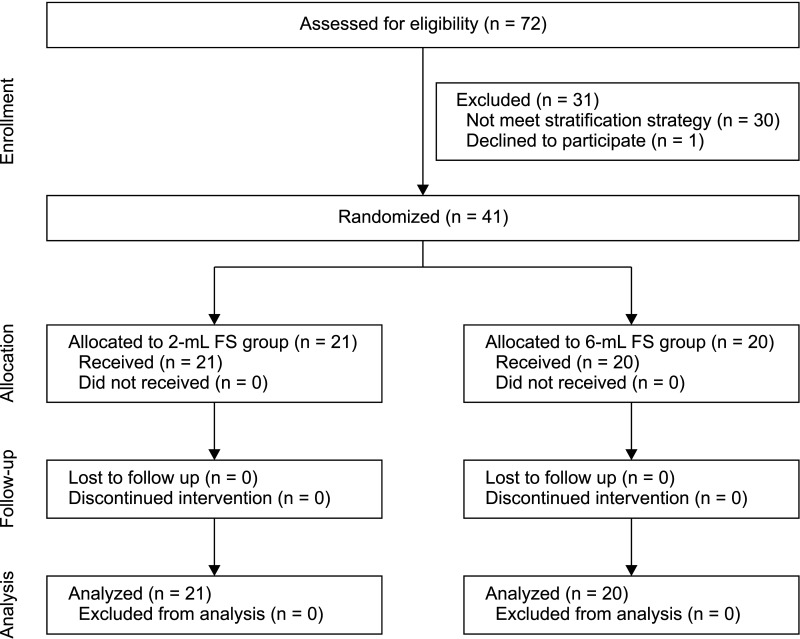Ann Surg Treat Res.
2022 Apr;102(4):177-184. 10.4174/astr.2022.102.4.177.
The effect of fibrin glue on the quantity of drainage after thyroidectomy: a randomized controlled pilot trial
- Affiliations
-
- 1Department of Radiology, Ajou University School of Medicine, Suwon, Korea
- 2Department of Surgery, Ajou University School of Medicine, Suwon, Korea
- KMID: 2527834
- DOI: http://doi.org/10.4174/astr.2022.102.4.177
Abstract
- Purpose
A seroma is a collection of exudates after surgical trauma in wound healing. Fibrin glue is used to prevent seroma by reducing the generation of exudate. However, the impact of fibrin glue on the prevention of seroma remains debatable. Therefore, we conducted a randomized controlled pilot trial to investigate the effect of the amount of fibrin glue used on the generation of exudate after thyroidectomy and the sample size of future definitive trials.
Methods
Between February and December 2020, 41 patients were enrolled; 21 patients in the low fibrin group and 20 in the high fibrin group. Stratified randomization was performed based on sex, body mass index, and thyroiditis. All patients underwent total thyroidectomy and bilateral central compartment dissection. In the low and high fibrin groups, 2 mL and 6 mL of fibrin glue were applied to patients, respectively.
Results
Both the total drain volume and flow rate during the first 12 hours were lower in the high fibrin group than in the low fibrin group (65.0 mL vs. 47.6 mL, P = 0.008 and 2.7 mL/hr vs. 1.8 mL/hr, P = 0.002, respectively). The calculated sample size for future randomized controlled trial was 32 patients (α = 0.05, power = 0.8), and the power of this trial was 0.91 with μ 1 = 2.7, μ 2 = 1.8, σ = 0.9, and α = 0.05 (μ = mean, σ = standard deviation).
Conclusion
Six milliliters of fibrin glue could reduce total drain volume and flow rate of exudate after thyroidectomy. Therefore, applying an appropriate amount of fibrin glue after thyroidectomy may reduce postoperative seroma.
Figure
Reference
-
1. Pogson CJ, Adwani A, Ebbs SR. Seroma following breast cancer surgery. Eur J Surg Oncol. 2003; 29:711–717. PMID: 14602488.
Article2. Portinari M, Carcoforo P. The application of drains in thyroid surgery. Gland Surg. 2017; 6:563–573. PMID: 29142849.
Article3. Budd DC, Cochran RC, Sturtz DL, Fouty WJ Jr. Surgical morbidity after mastectomy operations. Am J Surg. 1978; 135:218–220. PMID: 626296.
Article4. Carless PA, Henry DA. Systematic review and meta-analysis of the use of fibrin sealant to prevent seroma formation after breast cancer surgery. Br J Surg. 2006; 93:810–819. PMID: 16775816.
Article5. Sözen S, Topuz O, Tükenmez M, Keçeli M. The use of fibrin sealant after total thyroidectomy for benign disease obviates the need for routine drainage. Results of a randomized controlled trial. Hippokratia. 2011; 15:247–251. PMID: 22435023.6. Kim TW, Choi SY, Jang MS, Lee GG, Nam ME, Son YI, et al. Efficacy of fibrin sealant for drainage reduction in total thyroidectomy with bilateral central neck dissection. Otolaryngol Head Neck Surg. 2012; 147:654–660. PMID: 22627121.
Article7. Eweida AM, Ebeed HM, Sakr MF, Hamza Y, Gabr E, Koraitim T, et al. Independent predisposing factors for subcutaneous and deep wound collection after total thyroidectomy, a prospective cohort study. Ann Med Surg (Lond). 2018; 36:10–16. PMID: 30364680.
Article8. Kim HK, Kim SM, Chang H, Chun KW, Kim BW, Lee YS, et al. Anti-adhesive agent (Guardix-SG®) does not influence the drainage volume after thyroid cancer surgery. Korean J Endocr Surg. 2013; 13:251–256.
Article9. Barbaros U, Erbil Y, Aksakal N, Citlak G, Işsever H, Bozbora A, et al. Electrocautery for cutaneous flap creation during thyroidectomy: a randomised, controlled study. J Laryngol Otol. 2008; 122:1343–1348. PMID: 18312708.
Article10. Thomusch O, Machens A, Sekulla C, Ukkat J, Lippert H, Gastinger I, et al. Multivariate analysis of risk factors for postoperative complications in benign goiter surgery: prospective multicenter study in Germany. World J Surg. 2000; 24:1335–1341. PMID: 11038203.
Article11. Ayyash K, Khammash M, Tibblin S. Drain vs. no drain in primary thyroid and parathyroid surgery. Eur J Surg. 1991; 157:113–114. PMID: 1676302.12. Miri Bonjar MR, Maghsoudi H, Samnia R, Saleh P, Parsafar F. Efficacy of fibrin glue on seroma formation after breast surgery. Int J Breast Cancer. 2012; 2012:643132. PMID: 23008776.
Article13. McCaul JA, Aslaam A, Spooner RJ, Louden I, Cavanagh T, Purushotham AD. Aetiology of seroma formation in patients undergoing surgery for breast cancer. Breast. 2000; 9:144–148. PMID: 14731838.
Article14. Edwards SJ, Crawford F, van Velthoven MH, Berardi A, Osei-Assibey G, Bacelar M, et al. The use of fibrin sealant during non-emergency surgery: a systematic review of evidence of benefits and harms. Health Technol Assess. 2016; 20:1–224.
Article15. Ramouz A, Rasihashemi SZ, Daghigh F, Faraji E, Rouhani S. Predisposing factors for seroma formation in patients undergoing thyroidectomy: cross-sectional study. Ann Med Surg (Lond). 2017; 23:8–12. PMID: 28970942.
Article16. Lee I, Kim HK, Soh EY, Lee J. The association between chronic lymphocytic thyroiditis and the progress of papillary thyroid cancer. World J Surg. 2020; 44:1506–1513. PMID: 31915977.
Article17. Farwell AP, Braverman LE. Thyroiditis. Randolph GW, editor. Surgery of the thyroid and parathyroid glands. 2nd ed. Philadelphia: Saunders/Elsevier;2013. p. 42.
- Full Text Links
- Actions
-
Cited
- CITED
-
- Close
- Share
- Similar articles
-
- The Use of Fibrin Tissue Glue in Thyroid Surgery; A Randomized-Prospective Trial
- The Use of Fibrin Tissue Glue in Thyroid Surgery: Retrospective Study of 255 Cases
- The Effect of Additional Factor XIII on Cross-linking in Fibrin Glue
- Fibrin Glue Reduces the Duration of Lymphatic Drainage after Lumpectomy and Level II or III Axillary Lymph Node Dissection for Breast Cancer: A Prospective Randomized Trial
- Comparison of Hemostatic Effect of Endoscopic Injection with Fibrin Glue (FG) and Hypertonic Saline - epinephrine (HSE) for Peptic Ulcer Bleeding: A prospective randomized trial


